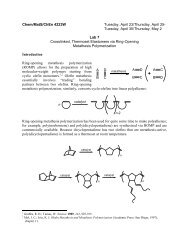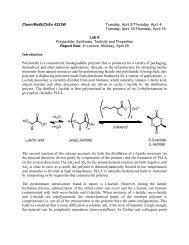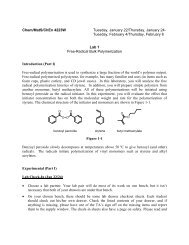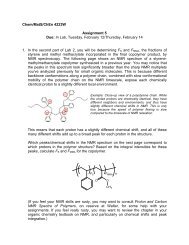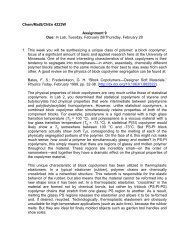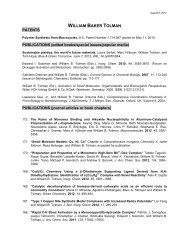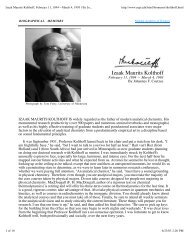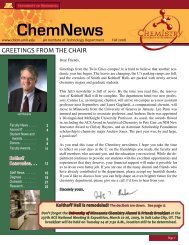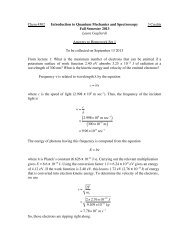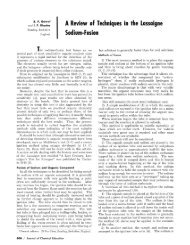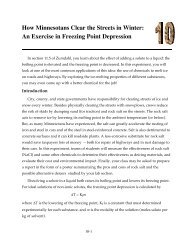Inverse Opal Photonic Crystals - Department of Chemistry ...
Inverse Opal Photonic Crystals - Department of Chemistry ...
Inverse Opal Photonic Crystals - Department of Chemistry ...
You also want an ePaper? Increase the reach of your titles
YUMPU automatically turns print PDFs into web optimized ePapers that Google loves.
FOREWARD<br />
This laboratory guide was conceived during the summer <strong>of</strong> Y2001 at the University <strong>of</strong><br />
Minnesota Materials Research Science and Engineering Center (UMN MRSEC) by Nagalingam<br />
Balakrishnan, a faculty member <strong>of</strong> the United Tribes Technical College who participated in the<br />
UMN MRSEC summer research program with his student Anna Gopher. This team worked in<br />
the research group <strong>of</strong> Pr<strong>of</strong>essor Andreas Stein in the <strong>Department</strong> <strong>of</strong> <strong>Chemistry</strong> <strong>of</strong> UMN, studying<br />
the synthesis <strong>of</strong> “inverse opals,” wherein uniformly sized polymer spheres are used as templates<br />
for sol-gel condensation reactions to produce inorganic solid replicas with uniformly spaced<br />
macropores. These materials are particularly intriguing because the uniform spacing <strong>of</strong> the<br />
macropores and the large periodicities result in peculiar optical properties that prevent the<br />
transmission <strong>of</strong> specific wavelengths <strong>of</strong> light. They are crystals in every sense <strong>of</strong> the word, but<br />
with the crystal lattice defined by the macropores. One glance at these crystals reveals light<br />
refraction identical to that observed in natural opals, which are simply crystals <strong>of</strong> uniformly<br />
spaced silica spheres. This laboratory guide has been prepared with the intention <strong>of</strong> teaching<br />
specific laboratory techniques – emulsion polymerization, templated sol-gel condensation,<br />
sintering, and optical measurements – to undergraduate students, and possibly high school<br />
students. We believe that the deep appreciation <strong>of</strong> jewelry and other artifacts, including opals,<br />
by Native American communities makes this a particularly attractive laboratory module for<br />
science instruction in tribal colleges.<br />
Special thanks are due Dr. Frank Snowden, the Associate Direction <strong>of</strong> the UMN Education and<br />
Human Resources program, for his coordination <strong>of</strong> the outreach activities that led to this guide.<br />
This guide would not have been possible without the generous support <strong>of</strong> the National Science<br />
Foundation, which provided funding for the UMN MRSEC and its summer research programs<br />
for external participants.<br />
Michael D. Ward<br />
Director, UMN MRSEC<br />
5



